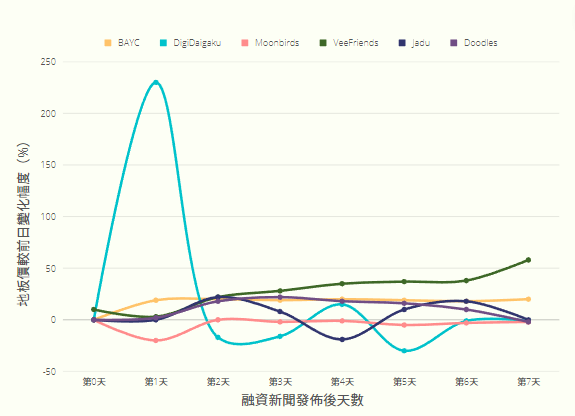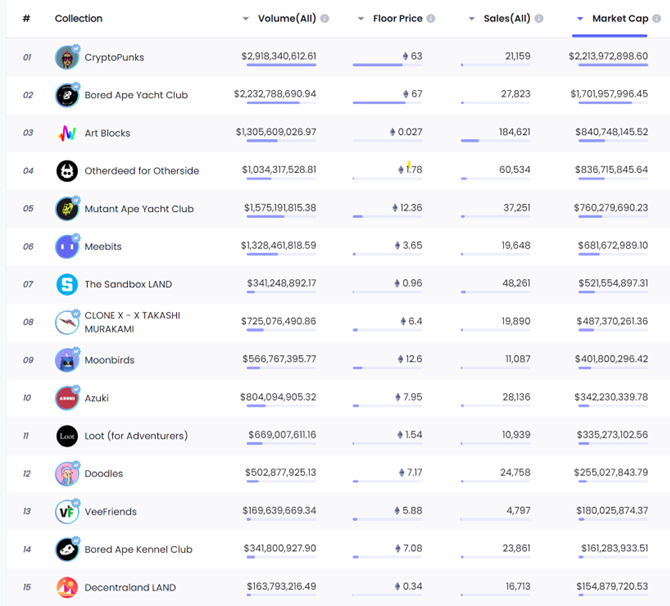벤처 캐피탈 기관이 지원하는 NFT 스타 프로젝트는 쫓을 가치가 있습니까?
오픈씨 전체 거래액은 8월 들어 5000만 달러 아래로 떨어졌지만 자본력은 속도를 내고 있는 것으로 보인다. NFT는 초기 OG 수집가부터 웹3 기업가, 새로운 비즈니스 시나리오를 찾는 웹2 물리적 산업에 이르기까지 성장했으며 이제 점점 더 많은 벤처 캐피탈 기관이 NFT 프로젝트 인큐베이팅에 직접 투자하기로 선택합니다. NFT 트랙의 투자 핫스팟은 더 이상 단순한 인프라나 NFTfi 프로토콜이 아닌 것 같습니다. 그리고 자본의 축복을 받은 이러한 NFT 프로젝트는 시장에 어떤 영향을 미칠까요? 개인 투자자로서 스타 벤처 캐피탈 기관의 축복을 받은 NFT 프로젝트의 행태를 어떻게 보아야 할까요?
이미지 설명

2022년 잘 알려진 NFT 프로젝트 파이낸싱 사례
통화 시장과 NFT 시장이 강세에서 약세로 바뀌었지만 기관이 시장에 진입하는 속도는 둔화되지 않았으며 다양한 유형의 NFT 프로젝트에 대한 지분을 계속 늘리고 있음을 알 수 있습니다. 그 중 DigiDaigaku의 freemint는 10 eth 이상의 바닥 가격으로 출시되어 8월 말 NFT 시장을 버리지 않게 만들었습니다. 그리고 이 현상은 또한 새로운 트렌드를 촉발시켰습니다. 즉, 소매업체가 스타 기관의 축복을 받은 프로젝트를 선호해야 할까요?
이미지 설명

파이낸싱 뉴스 릴리스 7일 후 프로젝트 가격 하한선 변경
NFT는 제쳐두고 Defi 프로젝트 자금 조달에 대해 이야기합시다. 종종 대규모 기관에서 승인하고 충분한 시작 자금을 확보한 프로젝트는 프로젝트가 개발 진행 속도를 높이고 상장 프로세스를 가속화할 수 있음을 의미합니다. 그렇기 때문에 많은 개인 투자자들이 상장 에어드랍에 대한 풍부한 수익을 얻기 위해 초기 단계에서 고품질 기관 자금 조달을 받은 프로젝트를 상호 작용하고 경험하는 것을 선택합니다.
그러나 NFT 프로젝트의 논리는 다릅니다. 우선 프로젝트 당사자로서 NFT 판매의 본질은 이미 자금조달 행위이며, 보통 프로젝트 당사자는 초기에 아무것도 없을 때 NFT를 판매하여 향후 실현하고자 하는 로드맵을 준비합니다. 따라서 이러한 NFT 프로젝트의 초기 보유자들은 스스로 벤처캐피탈을 하는 것으로 이해될 수 있으며, 차이점은 NFT 프로젝트 자체의 가치평가 논리와 그 이면에 있는 모회사의 가치평가 논리가 다르다는 것입니다. 또한 많은 NFT 프로젝트가 통화 발행 계획을 가지고 있지만 NFT 투자의 목적은 NFT 자체의 가치 상승을 위한 것입니까, 아니면 향후 통화 발행에 대한 기대입니까? NFT 자체가 향후 발행되는 토큰의 가치를 희석시킬까요? NFT 개인 보유자가 확인하기 어려운 문제입니다. 따라서 기관 자금 조달을 위해 Defi 프로젝트 만 참조하는 NFT 프로젝트의 모회사가 자금 조달을 받기 때문에 NFT가 상승 할 것이라고 생각하는 것은 바람직하지 않습니다.
그렇다면 기관 자금 조달을 받는 이러한 NFT 프로젝트의 모회사와 NFT 프로젝트의 시장 가치 사이의 관계는 무엇입니까? NFTGo의 데이터에 따르면 현재 NFT 프로젝트의 시장 가치에 따르면 Azuki만이 시장 지향적인 자금 조달을 수행하지 않았습니다.모회사인 Chiru Labs는 오랜 시간 동안 여전히 동양화의 최고 수준이며 독특합니다. 그리고 Azuki는 아주 일찍 국고 수익을 축적하기 시작했고 수억 개의 자산을 축적했습니다. 이 프로젝트의 인기로 인해 자금이 풍부해 졌다고 할 수 있습니다. 따라서 전략적 협력이 필요하지 않다면 절대 시장 기반 자금 조달의 길을 선택하지 않을 것입니다.
이미지 설명

NFT 프로젝트 평가 순위
그러나 이러한 회사의 지분을 보유하는 것은 NFT를 보유하는 것과 근본적으로 다릅니다.
우선 회사의 주주로서 기대하는 바는 단 하나, 금융투자수익률이다. 금융 투자의 수익률은 회사가 결국 공개될 수 있는지, 초기 투자 금액의 수십 또는 수백 배의 가격으로 인수될 수 있는지에 따라 달라집니다. 그리고 최종 결과를 결정하는 것은 회사가 충분한 이익을 창출할 수 있는지 여부입니다. 전통적인 web2 회사의 논리는 그들이 생산하는 제품이나 제공하는 서비스를 수입과 이익으로 교환한다는 것입니다. 하지만 NFT 프로젝트를 발행하는 회사로서 이 논리는 바뀌었습니다. 이 가상 상품이 "생산"되었지만 구매자 또는 보유자는 이 상품의 감상 또는 프로젝트 당사자의 에어드롭과 같은 부가 가치를 통해 실제 수입을 창출할 수 있을 것으로 기대합니다. 그리고 이 과정에서 프로젝트 자체에서 발생하는 수입이나 부가가치를 모회사와 NFT 보유자에게 어떻게 분배해야 하는가 하는 모순이 생기게 됩니다.
프로젝트 당사자가 바닥 가격을 더 높이기 위해 프로젝트의 게임 플레이 메커니즘과 관련된 에어드랍이나 현금 흐름과 같은 더 많은 혜택을 NFT 보유자에게 더 많이 분배하면 모회사의 수입은 자연스럽게 줄어들고 이익 성장률도 높아질 것입니다. 주주들은 또한 향후 자금 조달 및 상장에 영향을 미칠 회사의 미래 가치 성장 잠재력에 대해 큰 의구심을 갖게 될 것입니다. 그러나 프로젝트 당사자가 브랜드 가치와 수입에 대해 매우 화려하고 NFT 보유자와 에어드롭 발행 또는 수익 공유를 꺼리면 NFT의 가치가 떨어지며 결국 프로젝트의 전반적인 개발 진행에 영향을 미칠 것입니다. 따라서 중앙 집중식 NFT 프로젝트 당사자에게 주주와 NFT 보유자의 이익 균형을 맞추는 방법은 영원한 문제가 되었습니다.
이미지 설명

투자 기관, 프로젝트 당사자 및 NFT 보유자 간의 관계
작가:
작가:@ReffoNFT
자세한 내용은 SATCE 공식 웹 사이트를 참조하십시오.



